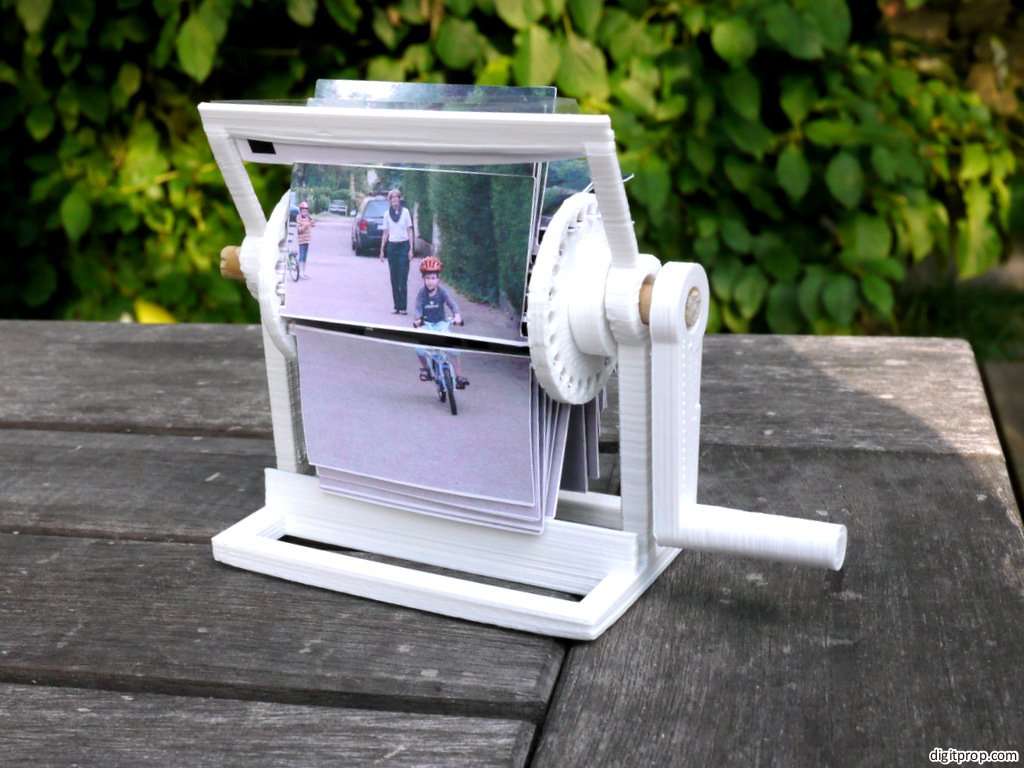
This is a 3D printed, very simple kinematoscope that you can actually build yourself (assuming you have a 3D printer or access to a service for printing them). You can turn virtually any video you have into a series of image cards for the kinematoscope. The video snippet should be a couple of seconds in length, and you will need 24 still images from it (see instructions for more details).
The kinematoscope makes a nice gift. It is easily printable without support, and has a hand-made aura, even when 3D printed. Print of all four required parts will take a total of less than 2 hours.
For the first version, I used a sequence from a video that is very special to me: It’s of my son learning to ride a bicycle.
This has been inspired by the giphoscope which was a bit outside my budget, although you will quickly realize that it’s good value for money when you consider the time and effort that goes into building your own.
Here is how to build one: The files are available on Youmagine.
Print the frame, two copies of the wheel, and the crank handle. It should print without problems, even without supports. I found that using a fan to cool the print in progress helps a lot in getting a nice result for the thin vertical bars.
You will need a wooden rod with about 7-8mm diameter. You could print one, of course, but I found that thin, round axles don’t lend themselves well for printing – it’s better to use an existing one than to reinvent the wheel.
As for the axle diameter, if it doesn’t fit, try to scale the model a bit.
Once you have all four parts plus the axle, you need to get image cards. You will find template files in CorelDraw and SVG format at the bottom of this post (the latter can be processed by the free program Inkscape).
You will now need individual still images from your video. There are several programs out there which can convert a video into a series of JPGs. The one I used is (‘Free Video to JPG Converter’)[https://www.dvdvideosoft.com/products/dvd/Free-Video-to-JPG-Converter.htm#.Ve8ElvmvHGg] by DVDVideoSoft. Be careful, though: The installer is evil and tries to install adware. use manual options and carefully unselect all optional things it tries to install.
Other than that, the program works nicely: You specify a video and how many frames it should take (or every n’th frame). Use frames spaced apart sufficiently to get some visible action with the kinematoscope. It does not work with subtle motion, so use every 10th frame or something.
This thing works best with a frame rate much lower than 24 images per second. You can crank it quite fast, but the images will blur together. So a frame rate of about 5 / sec works fine, and if you select every 10th frame, you get a nice little acceleration effect which helps to emphasize the action.
Once you have 24 images in a folder, import them into the Inkscape and lay them out in a perfectly aligned stack (use *Object -> Align and distribute’). Then, lay them out so that they fill the upper and lower half of a ‘frame’. Now, the pictures and frames need to be perfectly aligned.
What works best in order to achieve this is to move the whole stack and copy it 23 times, then go back and delete all but one picture in each stack.
Make sure that you keep track of the order of images, not just when laying out the page, but also later.
Once everything is in place, print the pages and cut out the 48 ‘half frame’ images. Make sure they are cut out as precisely as possible. Each half frame has a small ‘pin’ that goes into the holes of the wheels. In order for these pins to work, you need to use cardstock, not printer paper. I recommend something in the range of 180gsm (53lb bond/ledger).
Now glue one top half frame and one bottom half frame back-to-back, using the top half frame of an image and the bottom half frame of the next image. The last top half frame is glued to the first bottom half frame.
This will result in 24 double-sided cards.
Put the wheels on the axle and thread it through the holes of the frame. Then, glue the wheels on, using cyano acrylate. Make sure that their distance fits the width of the frames – it should be wide enough for the frames to rotate freely, but close enough so that they do not fall out. Then, glue on the handle and insert all 24 half frames. That’s it.
When turning the handle, the frames should get briefly stopped by the horizontal bars at the top and bottom. This is a bit finnicky, as it depends on the stiffness and thickness of the cardboard used, so it cannot be designed with 100% precision. If the frames are not stopped, tape a small piece of cardboard to the top and/or bottom bar (or redesign and print another version, if you really want it to be perfect).
